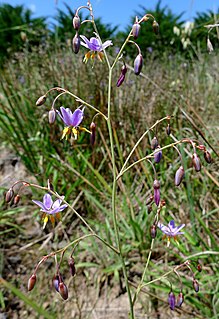
The lazuli bunting is a North American songbird named for the gemstone lapis lazuli.

Clarkia is a genus within the flowering plant family Onagraceae. Over 40 species are currently classified in Clarkia; almost all are native to western North America, though one species is native to South America.

Clarkia amoena is a flowering plant native to western North America, found in coastal hills and mountains from British Columbia south to the San Francisco Bay Area.

Zygaena carniolica, sometimes described as the crepuscular burnet or eastern burnet, is a member of the family Zygaenidae.
Nepotilla amoena is a species of sea snail, a marine gastropod mollusk in the family Raphitomidae.
Myurella amoena is a species of sea snail, a marine gastropod mollusk in the family Terebridae, the auger snails.
Anatoma amoena is a species of sea snail, a marine gastropod mollusk in the family Anatomidae.
Turbonilla amoena is a species of sea snail, a marine gastropod mollusk in the family Pyramidellidae, the pyrams and their allies.

Vexatorella is a genus containing four species of flowering plant, commonly known as vexators, in the family Proteaceae. The genus is endemic to the Cape Floristic Region of South Africa. The name means “little trouble-maker”, given with reference to the initial difficulties of placing V. latebrosa within the family. All species are shrubs which occur in dry fynbos habitats on the fringes of the Succulent Karoo ecoregion. The inflorescences are similar to those of the related leucospermums but also share features of the leucadendrons, with the floral bracts becoming woody and enlarged following pollination. The flowers are insect-pollinated, with the seeds dispersed by ants (myrmecochory).
Byrsia aurantiaca is a moth of the family Erebidae. It is found on Malacca, Borneo and Sumatra.
Byrsia buruana is a moth of the family Erebidae. It is found on Buru.
Byrsia dotata is a moth of the family Erebidae. It was described by Francis Walker in 1865. It is found on Sulawesi, Ambon Island, Batchian, Timor and New Guinea.
Colla amoena is a moth in the Bombycidae family. It was described by Paul Dognin in 1923. It is found in Brazil.

The Cisthenina are a subtribe of lichen moths in the family Erebidae, currently containing 428 described species.
The Nudariina are a subtribe of lichen moths in the family Erebidae. The taxon was described by Carl Julius Bernhard Börner in 1920.

Rubramoena amoena is a species of sea slug, an aeolid nudibranch, a marine gastropod mollusc in the family Fionidae.

Asteia amoena is a species of fly in the family Asteiidae. It is found in the Palearctic.

Vexatorella amoena, also known as the Swartruggens vexator is an evergreen shrub of up to about 1 m (3 ft) high, that is assigned to the family Proteaceae. It has entire, inverted egg-shaped, bluish grey, leathery leaves of 1½–3 cm (0.6–1.2 in) long and 5–11 mm (0.20–0.45 in) wide on a distinct stalk, and globular flower heads of about 2 cm (0.8 in) across with pale pink flowers with extended, thick-tipped styles at the tip of the branches. The plants are flowering from September to November. It is an endemic species that is restricted to the Western Cape province of South Africa.

Felicia amoena is a variably hairy, sometimes glandular, biennial or perennial plant, of about 25 cm (10 in) high, that is assigned to the daisy family. It is somewhat woody at its base, roots at the nodes if these contact the soil, and has ascending branches. The leaves are oppositely arranged along the stems at and just above a branching fork, further up. The flower heads sit individually on up to 12 cm long stalks. They are 2–3 cm in diameter and consist of about twelve to twenty five heavenly blue ray florets that surround many yellow disc florets. Three subspecies have been recognised, that differ in width of the leaves and the involucral bracts, the size of the heads and number of ray florets and in having glandular hairs. These can be found in coastal sands and inland areas in the Western Cape and Eastern Cape provinces of South Africa. Flower heads can be found from June till October.

Dianella amoena, commonly known as the matted flax-lily, is an endangered, herbaceous, perennial plant endemic to Australia. It belongs to the family Asphodelaceae, subfamily Hemerocallidoideae. It has long grey-green leaves which grow in clumps from an underground rhizome, and displays blue-purple flowers in spring-summer, up to 90cm in height. The common name Matted Flax-lily refers to its extensively rhizomatous nature, sometimes forming large mats up to 5m wide.









